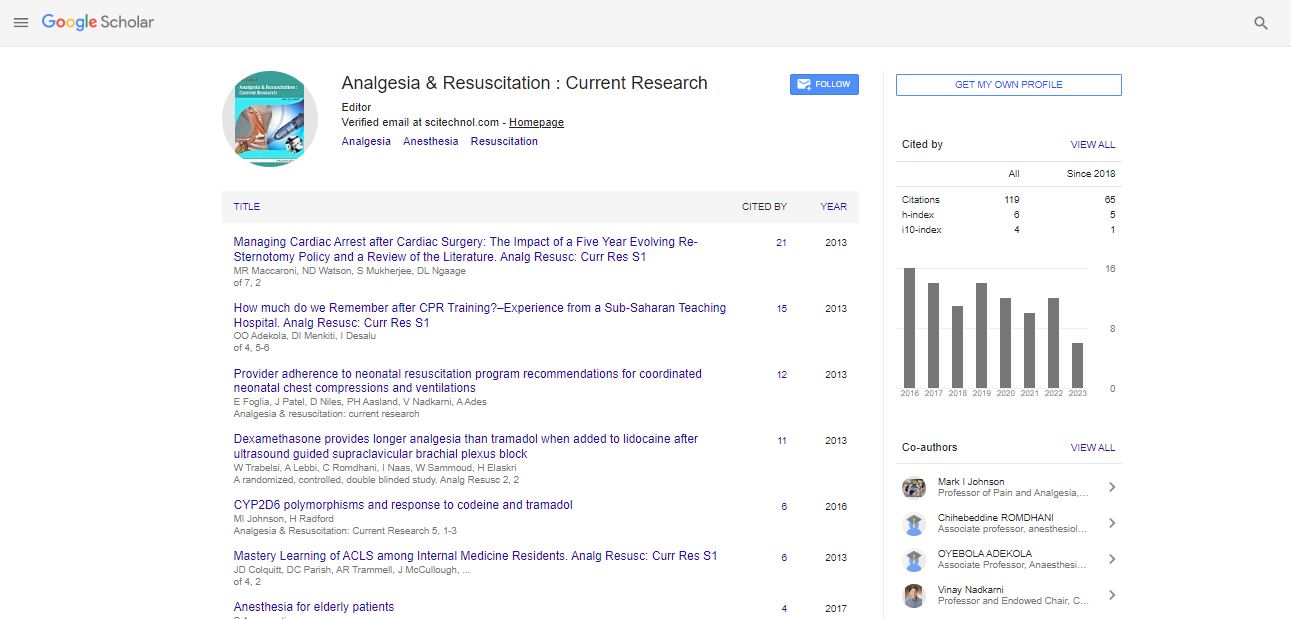Research Article, Analg Resusc Curr Res Vol: 5 Issue: 2
Assessing Adherence to Advanced Cardiovascular Life Support (ACLS) Protocols in Residents during Simulated Cardiac Arrest
| Kennedy R, Sharma S, Gu Y, Mike Butler, Haroon Babar and Witter Tobias* |
| Department of Anesthesia, Pain Management and Perioperative Medicine, Faculty of Medicine, Dalhousie University, Canada |
| Corresponding author : Witter Tobias Department of Anesthesia, Pain Management & Perioperative Medicine, Faculty of Medicine, Dalhousie University, Bethune Bldg Halifax, Nova Scotia-B3H 2Y9 Canada Tel: 9024733486 E-mail:tobias.witter@nshealth.ca |
| Received: September 22, 2016 Accepted: November 03, 2016 Published: November 07, 2016 |
| Citation: Kennedy R, Sharma S, Gu Y, Butler M, Babar H, et al. (2016) Assessing Adherence to Advanced Cardiovascular Life Support (ACLS) Protocols in Residents during Simulated Cardiac Arrest. Analg Resusc: Curr Res 5:2. doi: 10.4172/2324-903X.1000142 |
Abstract
Background: Advanced cardiac life support (ACLS) has been the recognized standard of care in cardiac arrest since 1974. Studies have demonstrated the importance of adherence to ACLS algorithms during cardiac arrests in improving return of spontaneous circulation and survival to hospital discharge. Despite this, many residents feel unprepared about their resuscitation skills, and those feeling confident may be falsely self-assured. The objective of this study was to analyze adherence to ACLS guidelines in a standardized simulated cardiac arrest scenario.
Methods: This study used an observational design to evaluate adherence to ACLS protocol in residents during cardiac event simulations. 36 residents were exposed to the same scenario of ventricular fibrillation and were filmed and reviewed by two independent scorers. Their adherence to ACLS protocols was measured using a standardized checklist based on the 2010 AHA guidelines.
Results: Overall adherence to ACLS protocol was fair (79.1%). Residents consistently performed well in their initial assessment (88.0% adherence) and initiation of chest compressions once pulselessness was detected (97.2%). Quality of CPR was high in terms of hand placement, compression depth, and rate (97.2%; 88.9%; 97.2%); however, half (52.8%) of the residents failed to place the backboard under the patient. Residents struggled to keep CPR interruptions under 10 seconds during rhythm analysis and pulse checks (55.6% and 59.7% respectively). Also, only 63.9% of the residents correctly identified the rhythm and communicated it with the team. Most notably, no resident delivered a shock in less than 1 minute from rhythm onset.
Conclusion: In our study, residents at our institution demonstrated overall satisfactory adherence to the 2010 ACLS guidelines, especially in the detection of pulselessness and initiation of CPR. Future training should emphasize rhythm analysis and minimizing CPR interruptions during defibrillation and rhythm/pulse checkspotentially leading to better outcomes in patients suffering a cardiac arrest.

